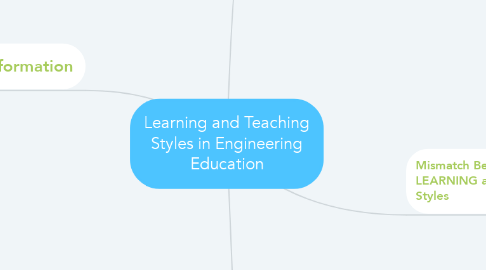
1. Information
1.1. Input
1.1.1. Organization
1.1.1.1. Processing
1.1.1.1.1. Understanding
1.1.1.1.2. Reflective learner
1.1.1.1.3. ACTIVE STUDENT PARTICIPATION
1.1.1.1.4. Active learner
1.1.1.2. Deductive learner
1.1.1.2.1. deduces consequences
1.1.1.3. Inductive learner
1.1.1.3.1. infer principles
1.1.2. auditory learner
1.1.2.1. verbal presentation
1.1.2.1.1. LIKE
1.1.2.1.2. REMEMBER BEST
1.1.2.1.3. DON`T LIKE
1.1.3. visual learner
1.1.3.1. visual presentation
1.1.3.1.1. LIKE
1.1.3.1.2. REMEMBER BEST
1.1.3.1.3. DON`T LIKE
1.2. intuitive learner
1.2.1. concret information
1.2.1.1. LIKE
1.2.1.1.1. Principles
1.2.1.1.2. Inovation
1.2.1.2. QUICK
1.2.1.2.1. CARELESS
1.2.1.3. GOOD AT
1.2.1.3.1. Grasping New Concepts
1.2.1.4. DON`T LIKE
1.2.1.4.1. Repetition
1.3. sensing learner
1.3.1. abstract concepts
1.3.1.1. LIKE
1.3.1.1.1. Experimental
1.3.1.1.2. Detail
1.3.1.2. GOOD AT
1.3.1.2.1. Memorizing Facts
1.3.1.3. CAREFUL
1.3.1.3.1. SLOW
1.3.1.4. DON`T LIKE
1.3.1.4.1. Surprises
2. Most of Engineering Student's Learning Style
3. Most of Engineering Teaching Styles
4. Mismatch Between LEARNING and TEACHING Styles
4.1. CONSEQUENCES
4.1.1. POOR STUDENT PERFORMANCE
4.1.2. PROFESSORIAL FRUSTRATION
4.1.3. LOST OF POTENTIALLY EXCELLENT ENGINEERS
4.2. SOLUTION
4.2.1. Teaching Techniques To Address All Learning Styles
4.2.1.1. Motivate Learning
4.2.1.2. Provide a Balance of:
4.2.1.2.1. Concret information
4.2.1.2.2. Abstract concepts
4.2.1.2.3. Practical Problem-Solving Methods
4.2.1.2.4. Emphasize fundamental understanding
4.2.1.3. Follow the Scientific Method
4.2.1.3.1. Provide Concrete Examples
4.2.1.4. Use Visual Presentation of Verbal Material
4.2.1.4.1. Films
4.2.1.4.2. Pictures
4.2.1.4.3. Graphs
4.2.1.5. Computer-assisted Instruction
4.2.1.6. Do not fill all the class time by lecturing and writing on the board
4.2.1.6.1. Provide intervals
4.2.1.6.2. Let students think about it
4.2.1.7. Provide actives
4.2.1.7.1. Small-Group Brainstorming
4.2.1.8. Assign some exercises
4.2.1.8.1. Do not overdo them
4.2.1.8.2. Open-Ended Problems
4.2.1.8.3. Analysis and Synthesis
4.2.1.9. Give the option of cooperating on homework assignments
4.2.1.10. Applaud creative solutions
4.2.1.11. Talk about learning styles
4.2.1.11.1. Find the academic difficulties
4.2.1.11.2. Explain how to learn more efficiently

